By Paul Roggemans, Beat Booz, Stefano Sposetti and Jochen Richert
Abstract: The October zeta Perseids have been reported as a newly discovered meteor shower, now listed in the Working List of meteor showers of the IAU Meteor Data Center. The Swiss FMA video camera network registered one additional orbit during the short activity interval on 2021 October 24. CAMS BeNeLux had finally 4 orbits of this shower, two in common with GMN. A recent stream search on GMN orbit data revealed two more of these peculiar orbits on 2021 October 29, 5 days after the discovery date.
Introduction
During the night of 24–25 October 2021, a new long-period meteor shower has been discovered by the Global Meteor Network. The shower experienced a sharp outburst at solar longitude 211.36° (Vida et al., 2021). Meanwhile, the shower has been listed as number 1131 in the IAU MDC shower database (Jenniskens et al., 2020; Jopek and Kaňuchová, 2017; Jopek and Jenniskens, 2011; Neslušan et al., 2020).
Since the first publication about the discovery of this meteor shower, some more information has been collected which is documented in this article.
Supporting evidence from FMA
The Swiss Fachgruppe Meteorastronomie video meteor network recorded 59 meteors during the night of 2021 October 24–25 within the interval 19h10m–22h13m UT when Global Meteor Network detected 14 October zeta Perseids. A quick check on the multi-station data revealed that one meteor at 20h47m52s UT belonged to the newly discovered meteor shower.
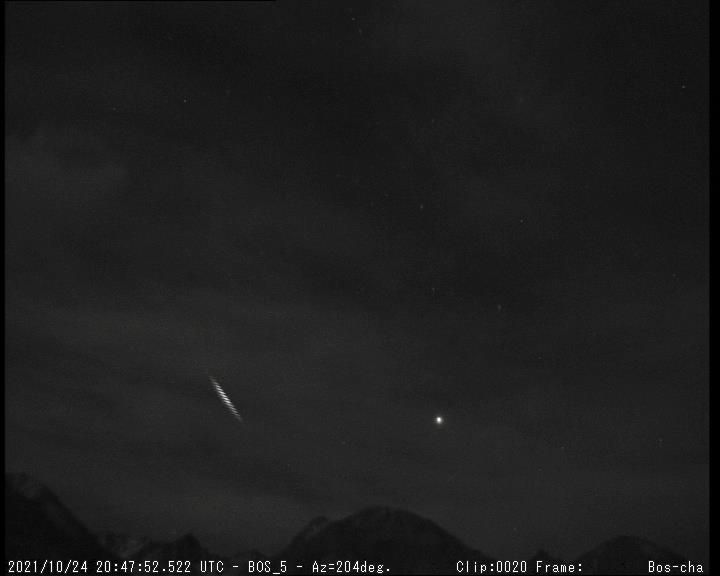
Figure 1 – M20211024_204752 recorded by the FMA video meteor network, image taken with cam no. 5 of station Bos-cha (BOS) by Jochen Richert.
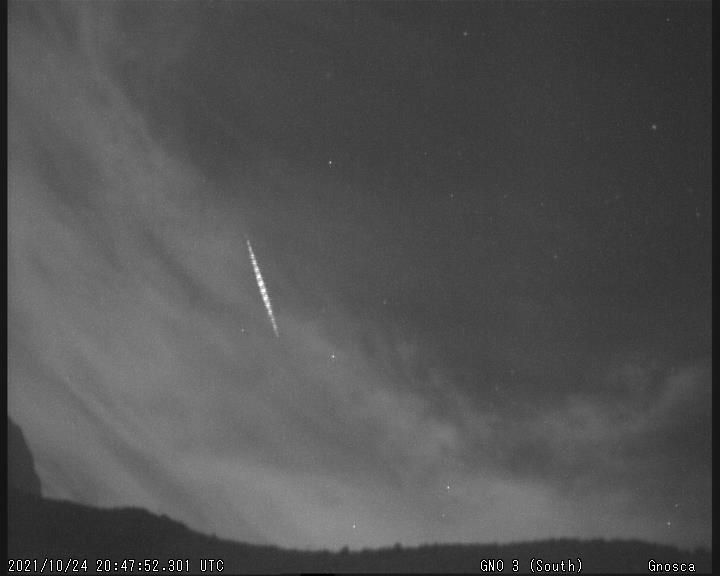
Figure 2 – M20211024_204752 recorded by the FMA video meteor network, image taken from the station GNO by Stefano Sposetti.
This meteor was captured simultaneously by Stefano Sposetti (Locarno and Osservatorio Astronomico di Gnosca) and Jochen Richert (Privatsternwarte Bos-cha). Figure 1 shows the meteor registered by Jochen Richert and Figure 2 the meteor registered by Stefano Sposetti. The following data and orbit have been computed by Beat Booz:
- λʘ = 211.36°
- αg = 59.4°
- δg = +32.3°
- Hb = 108.5 km
- He = 90.6 km
- vg = 49.9 km/s
- a = 31 AU
- q = 0.0827 AU
- e = 0.9973
- ω = 326.74°
- Ω = 211.36°
- i = 70.1°
- Π = 178.1°
This orbit is very similar to the reference orbit listed for the October zeta Perseids (Vida et al., 2021) with discrimination criteria DSH = 0.086 (Southworth and Hawkins, 1963) and DD = 0.031 (Drummond, 1981). This contribution by the FMA network is most valuable additional evidence for the meteor shower, obtained by an independent network using a different solver than GMN or CAMS.
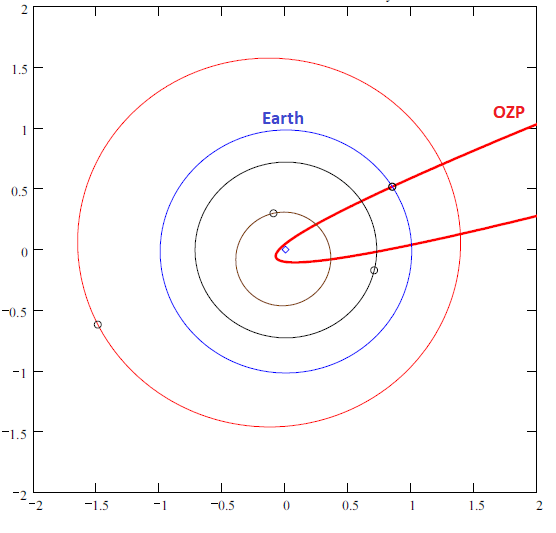
Figure 3 – The October zeta Perseid orbit relative to the Sun and the inner planets (courtesy Beat Booz).
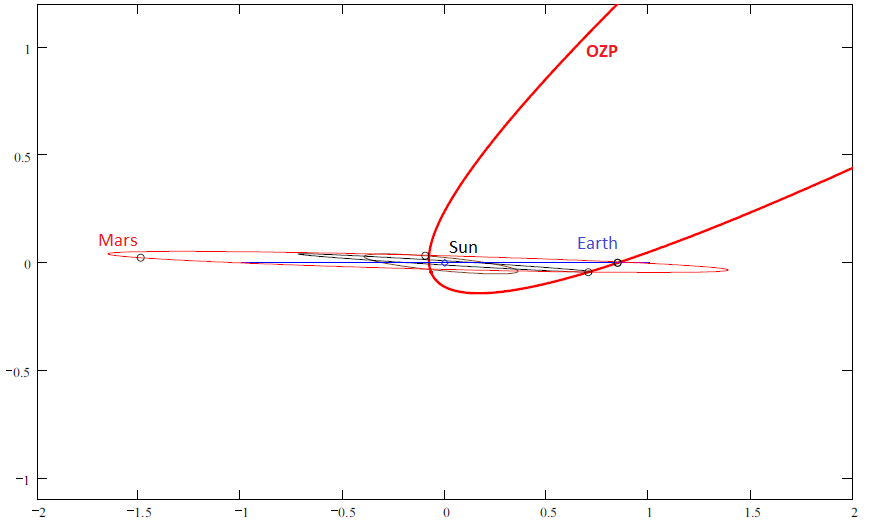
Figure 4 – The October zeta Perseid orbit relative to the Sun the inner planets and the ecliptic plane (courtesy Beat Booz).
Four OZP orbits by CAMS-BeNeLux
At the time of the first publication (Vida et al., 2021), a preliminary check on CAMS-BeNeLux data yielded 650 orbits for the night October 24–25, including two October zeta Perseid orbits. When all the data had been collected and could be analyzed, 3621 confirmed meteors were reported of which 2346 were multi-station, good for 715 orbits including four October zeta Perseid orbits. Clouds interfered this night at several stations and reduced the chances to obtain paired meteors.
Figure 5 – The October zeta Perseid meteor registered on 2021, October 24, at 20h21m10s UT. CAMS Watec 3900 at Nancy, France (photo Tioga Gulon).
The first OZP meteor was recorded at 20h21m10s UT, initially reported double station between Mechelen (Luc Gobin) and Wilderen (Jean-Marie Biets), this meteor was also recorded at Nancy (Tioga Gulon) and at Zoersel (Bart Dessoy). This was a rather faint meteor (see Figure 5). A new orbit has been obtained for the combination of these four camera stations.
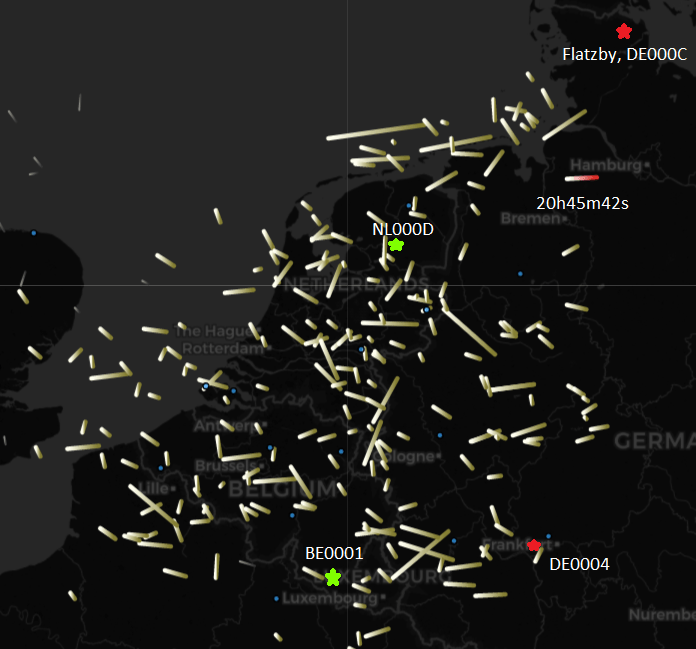
Figure 6 – The meteor map with the trajectory of the OZP meteor on 2021, October 24 at 20h45m42s near Hamburg computed by the GMN trajectory solver and the camera locations used by CAMS BeNeLux and GMN.
Figure 7 – The OZP meteor on 2021, October 24 at 20h45m42s UT recorded at Flatzby by the 6mm RMS camera DE000C (Reinhard Kühn) which was used by both CAMS BeNeLux and GMN.
Figure 8 – The OZP meteor at 20h45m42s UT recorded at Grapfontaine by the 3.6mm RMS camera BE0001 (Paul Roggemans) which was used by CAMS BeNeLux but rejected by the quality control of the GMN-solver. The meteor appears in the bottom right corner of the FoV.
The second OZP meteor was recorded at 20h40m18s UT and remained double station between Mechelen (Luc Gobin) and Wilderen (Jean-Marie Biets), without any other camera contributing.
The third OZP meteor is as far as known the most beautiful of all recorded OZP meteors and appeared at 20h45m43s. This event doesn’t increase the total number of OZP orbits as the same meteor appears among the 14 OZP meteors detected by Global Meteor Network, be it obtained from a different camera combination than within CAMS BeNeLux. The CAMS trajectory solver used the output obtained from three RMS cameras active within the CAMS network: BE0001 (Paul Roggemans) at Grapfontaine, NL000D (Tammo Jan Dijkema) at Dwingeloo and DE000C (Reinhard Kühn) at Flatzby, while GMN based its orbit on the combination of DE000C at Flatzby and RMS DE0004 (Jürgen Dörr) near Frankfurt, a camera which does not participate in the CAMS network (see Figure 6). The orbits obtained by CAMS-BeNeLux and by GMN are compared in Table 1.
The reason why the quality control of the trajectory solver of GMN rejected the data from BE0001 and NL000D looks obvious when we look at the images. On the map in Figure 6 we see that BE0001 in the south-east of Belgium was far away from the meteor and on Figure 8 we see the meteor low above the NNE horizon in a corner at the edge of the FoV where the optical distortion is the most problematic. A large distance to the meteor combined with an angular error on the measured position is not ideal. NL000D at Dwingeloo (Figure 6) was at a suitable distance from the meteor but got the bright Moon right next to the meteor trail reducing the number of reference stars and therefore limiting the calibration quality (Figure 9).
Figure 9 – The OZP meteor at 20h45m42s UT recorded at Dwingeloo by the 3.6mm RMS camera NL000D (Tammo Jan Dijkema) which was used by CAMS BeNeLux but rejected by the quality control of the GMN-solver. The meteor appears left from the Moon.
Figure 10 – The OZP meteor at 20h45m42s UT recorded by the 3.6mm RMS camera DE0004 (Jürgen Dörr) which was used by the GMN trajectory solver but not available for CAMS BeNeLux.
RMS DE000C at Flatzby (Figure 6) was at about the same distance from the meteor as NL000D, but with plenty of reference stars and a very good calibration (Figure 7). RMS DE0004 near Frankfurt (Figure 6) is also far away from the meteor trajectory but registered the meteor trail closer to the center of the FoV with plenty of stars available for a good calibration (Figure 10). It is obvious that the best combination was DE000C with DE0004.
Table 1 – Two October zeta Perseid meteors recorded 2021 October 24 by RMS cameras and analyzed independently by CAMS and GMN.
| 20h45m43s | 20h53m16s | |||
| GMN | CAMS | GMN | CAMS | |
| λʘ (°) | 211.36 | 211.36 | 211.37 | 211.37 |
| αg (°) | 58.0 | 58.6 | 58.7 | 58.6 |
| δg (°) | +33.8 | +33.9 | +34.3 | +34.0 |
| αo (°) | 58.0 | 58.1 | 58.7 | 58.0 |
| δo (°) | +34.1 | +34.3 | +34.7 | +34.5 |
| Hb (km) | 107.8 | 110.3 | 106.0 | 106.6 |
| He (km) | 81.1 | 80.1 | 95.3 | 96.0 |
| vg (km/s) | 48.3 | 50.0 | 46.9 | 46.8 |
| mA | –3.2 | – | –0.1 | –0.6 |
| λ-λʘ (°) | 211.76 | 212.25 | 212.46 | 212.30 |
| β (°) | +13.3 | +13.3 | +13.7 | +13.4 |
| a (AU) | – | – | 7.58 | 7.65 |
| q (AU) | 0.0834 | 0.0820 | 0.0860 | 0.0835 |
| e | 1.0002 | 1.0087 | 0.9887 | 0.9891 |
| ω (°) | 326.30 | 325.82 | 326.89 | 327.37 |
| Ω (°) | 211.361 | 211.361 | 211.367 | 211.367 |
| i (°) | 64.9 | 70.9 | 63.7 | 62.7 |
| Π (°) | 177.66 | 177.18 | 178.26 | 178.73 |
Comparing the output of the trajectory solvers for CAMS and GMN in Table 1, the results are not identical but still in good agreement. For CAMS it was the good quality data from Flatzby that saved the solution in combination with the less favorable BE0001 and NL000D camera data. The largest difference between both results is in the absolute magnitude where CAMS suggests mA = –13.1 and GMN –3.2, the latter being the most realistic value. Both Denis Vida and Martin Breukers warn that the brightness determination is not reliable. A manual reduction for CAMS by Martin Breukers revealed mA = –2.6. CAMS measured a higher geocentric velocity, 50.0 km/s against 48.3 km/s for GMN, a difference that accounts for the higher inclination i of the orbit. All other orbital parameters are still acceptable in spite of the less favorable combination used by the trajectory solver of CAMS.
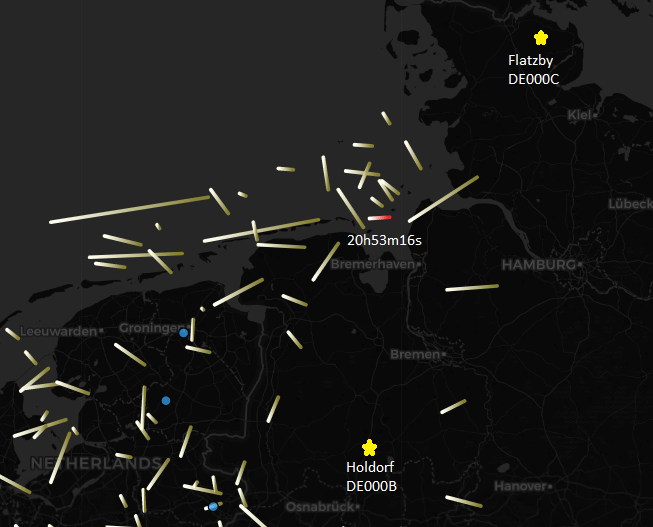
Figure 11 – The meteor map with the trajectory of the OZP meteor on 2021 October 24 at 20h53m16s UT, recorded from Flatzby and Holdorf computed by the GMN trajectory solver.
Figure 12 – The OZP meteor at 20h53m16s UT recorded by the 6mm RMS camera DE000C at Flatzby (Reinhard Kühn) which was used by both the GMN trajectory solver and the CAMS trajectory solver.
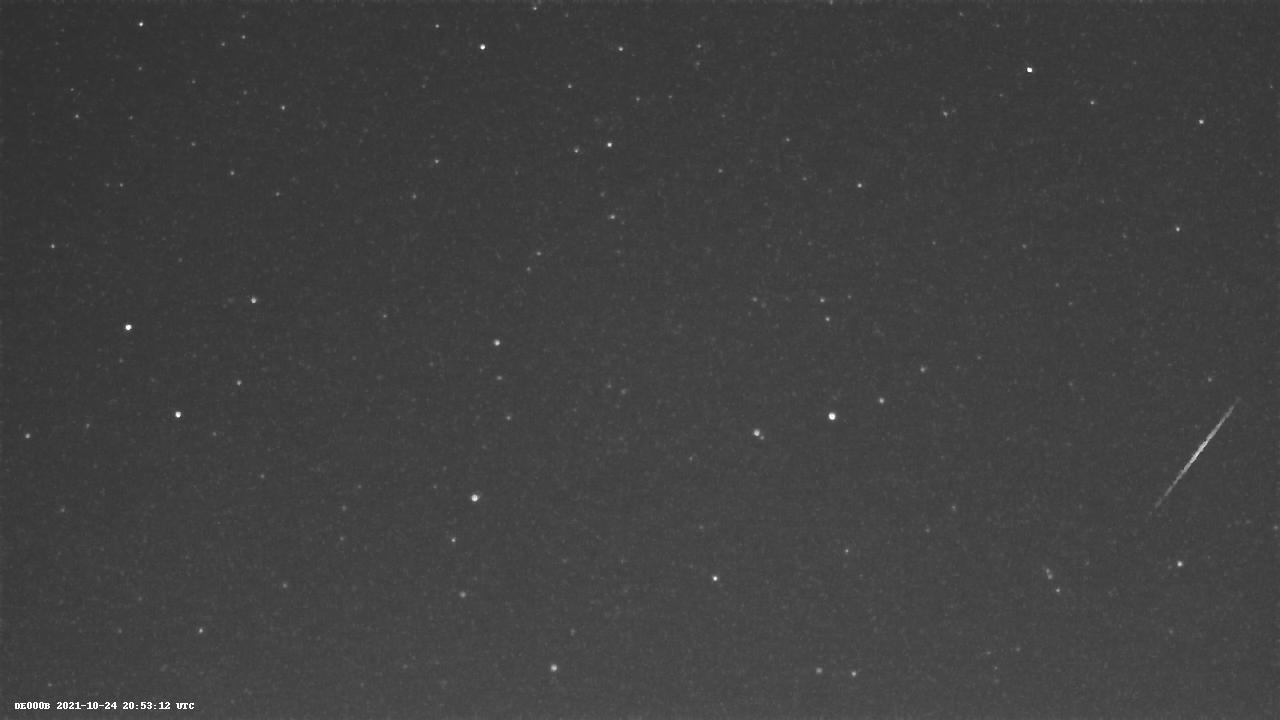
Figure 13 – The OZP meteor at 20h53m16s UT recorded by the 6mm RMS camera DE000B at Holdorf (Ludger Börgerding) which was used by both the GMN trajectory solver and the CAMS trajectory solver.
The fourth OZP meteor was recorded at 20h53m16s UT (Figure 11) by the two RMS cameras DE000C operated by Reinhard Kühn at Flatzby (Figure 12) and DE000B operated by Ludger Börgerding at Holdorf (Figure 13) which both participate in the CAMS-BeNeLux network and in the Global Meteor Network. In this case the same DetectInfo positional data was used by both the trajectory solver of CAMS and the trajectory solver of GMN.
Using the exact identical input data for both trajectory solvers does not result in exactly the same numeric output, but the results are in very good agreement (Table 1).
Both RMS cameras had plenty of reference stars for calibration and both use a 6mm lens which is recommended within CAMS-BeNeLux because its optical accuracy proved to be significantly better than the 3.6mm lenses. Not only the error margins on the measured positions but also the methodology of the trajectory solver has influence on the differences in the numeric output of orbit computations.
Table 2 – Comparing the mean orbits obtained by Global Meteor Network (14 orbits), CAMS (4 orbits) and FMA (1 orbit).
| GMN | CAMS | FMA | |
| a (AU) | 41 | 45 | 31 |
| q (AU) | 0.0820 | 0.0808 | 0.0827 |
| e | 0.998 | 0.9982 | 0.9973 |
| i (°) | 65.2 | 67.9 | 70.1 |
| Ω (°) | 211.38 | 211.389 | 211.36 |
| ω (°) | 326.8 | 326.98 | 326.74 |
The four October zeta Perseid orbits obtained by CAMS BeNeLux result in a slightly different mean orbit than the preliminary results based on two orbits. The final result compares better to the GMN than the preliminary published CAMS results in Vida et al. (2021). In Table 2 we compare the results obtained by GMN, CAMS and FMA.
Some late October zeta Perseids?
Running a shower search through the entire GMN meteor orbit dataset with 341249 orbits (version 13 November 2021) to locate the 14 OZP orbits, to our surprise we found 16 instead of 14 OZP orbits. Two more of these peculiar orbits had been recorded on October 29, a first at 04h59m51s UT in Canada by RMS cameras CA000F, CA000Q and CA000S. The second one appeared at 09h06m41s UT and was recorded in the USA by RMS cameras US0001, US0004, US0008, US000A, US000C, US000H and US000P.
The orbits of these two events have a close match with the GMN reference orbit of October 24 for the OZP meteoroid stream with DD = 0.069 and DD = 0.031 as discrimination criteria according to Drummond (1981). The parameters for these two orbits are compared in Table 3.
Note that a stream search on 1326006 orbits collected by CAMS, EDMOND, SonotaCo and Global Meteor Network before 2021, revealed 20 candidate OZP orbits recorded between 2007 and 2020 on nights before and up to one week later than October 24 (Vida et al., 2021).
A search through the orbit datasets for 2021 of other major video meteor networks would be worthwhile.
Table 3– Two October zeta Perseid meteors recorded 2021 October 29 by RMS cameras in Canada and the USA.
| 20211029_045951 | 20211029_090641 | |
| λʘ (°) | 215.693 | 215.865 |
| αg (°) | 62.8 | 63.6 |
| δg (°) | +35.6 | +35.7 |
| vg (km/s) | 47.8 | 47.8 |
| λ-λʘ (°) | 211.7 | 212.3 |
| β (°) | +14.2 | +14.3 |
| a (AU) | 30 | 18 |
| q (AU) | 0.09438 | 0.09269 |
| e | 0.9969 | 0.9948 |
| ω (°) | 324.38 | 324.90 |
| Ω (°) | 215.693 | 215.866 |
| i (°) | 64.4 | 65.9 |
| Π (°) | 180.07 | 180.76 |
| DD | 0.069 | 0.031 |
Conclusion
Some additional evidence has been found for the recently discovered October zeta Perseids with one more orbit obtained by the Swiss FMA video meteor network. The final results for CAMS-BeNeLux resulted in four OZP orbits. Two of these meteors were used independently by both CAMS-BeNeLux and Global Meteor Network and offered an interesting opportunity to compare the results obtained by two different trajectory solvers. The number of operational RMS cameras in the CAMS-BeNeLux area is still too low to provide a good coverage for the Global Meteor Network. More cameras are required. Another aspect is the size of the network. The GMN covers a much larger part of the atmosphere than CAMS-BeNeLux and therefore has better chances to detect enough meteors to reveal unexpected short-lived activity caused by unknown meteor showers.
Acknowledgment
The authors thank all the camera operators for their efforts to keep their cameras running in order not to let any unexpected activity pass unnoticed. We thank in particular the people who provided data and photographs for this article: Ludger Börgerding, Tammo Jan Dijkema, Jürgen Dörr, Tioga Gulon, Reinhard Kühn, Jochen Richert, Stefano Sposetti and Jonas Schenker for coordinating the communication. We thank Martin Breukers for his efforts to provide the orbits obtained by CAMS-BeNeLux. We also thank Tammo Jan for making the meteor map available to the meteor community. The meteor map is a popular tool within the Global Meteor Network to view the meteor trajectories, camera positions, camera FoVs, etc.
References
Drummond J. D. (1981). “A test of comet and meteor shower associations”. Icarus, 45, 545–553.
Jenniskens P., Jopek T.J., Janches D., Hajduková M., Kokhirova G.I., Rudawska R. (2020). “On removing showers from the IAU Working List of Meteor Showers”. Planetary and Space Science, 182, id. 104821.
Jopek T. J. and Kaňuchová Z. (2017). “IAU Meteor Data Center – the shower database: A status report”. Planetary and Space Science, 143, 3–6.
Jopek T. J. and Jenniskens P. M. (2011). “The Working Group on Meteor Showers Nomenclature: A History, Current Status and a Call for Contributions”. In Meteoroids: The Smallest Solar System Bodies, Proceedings of the Meteoroids Conference held in Breckenridge, Colorado, USA, May 24-28, 2010. Edited by W.J. Cooke, D.E. Moser, B.F. Hardin, and D. Janches, NASA/CP-2011-216469, 7–13.
Neslušan L., Poručan V., Svoreň J., Jakubík M. (2020). “On the new design othe IAU MDC portal”. WGN, Journal of the International Meteor Organization, 48, 168–169.
Southworth R. R. and Hawkins G. S. (1963). “Statistics of meteor streams”. Smithson. Contrib. Astrophys., 7, 261–286.
Vida D., Šegon D., Roggemans P. (2021). “October zeta Perseid meteor shower (OZP#01131)”. eMetN, 6, 536–539.






Hello Paul, hello everyone. If you are interested, then on that night of October 24/25, the Belarusian video meteor network also registered 3 meteors belonging to the OZP. Here is the result of processing in UFOOrbit:
20:41:37UT (by 3 cams, quality Q2), ra=58.3°, dec=34.0°, vg=47.7km/s, a=18.2AU, q=0.085AU, e=0.995, peri=326.489°, node=211.358°, incl=64.5°
20:49:56UT (by 3 cams, quality Q2), ra=57.0°, dec=33.0°, vg=47.5km/s, a=73.0AU, q=0.082AU, e=0.999, peri=326.655°, node=211.364°, incl=59.0°
22:02:15UT (by 2 cams, quality Q1), ra=58.2°, dec=33.8°, vg=45.5km/s, a=4.9AU, q=0.086AU, e=0.983, peri=326.512°, node=211.512°, incl=58.1°
Raw material (excluding RMS cameras) as well as more complete processed data can be downloaded from the link:
https://drive.google.com/file/d/1A5i042_0QvzWv4L2Ir41qdCN7L8KyJhq/view?usp=sharing
Best regards,
Yuri Goryachko